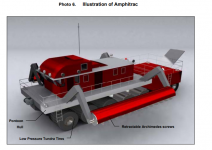03/31/2012. Gordon Ashmore was Columbia Helicopters' Maintenance Manager at the time this photo was taken. The following was transcribed from the Columbia Helicopters
website:
In June 1982, Columbia Helicopters was hired by Sohio to participate in a test on Alaska's North Slope. The purpose of this test was to evaluate the ability of a helicopter - the Boeing Vertol 107-II - to tow a fully-loaded hover barge over water, snow and ice.
The test began in Prudhoe Bay on June 17. The Vertol's 600-foot long line was connected to hover barge ACT-100, jointly owned by Global Marine Development and VECO. Air blowers on the 170-ton (340,000 lb, 154,221 kg) barge forced a cushion of air under the barge, which was kept in place by rubberized skirt material.
This first test was run around Prudhoe Bay with an empty barge, and was successful. During this and subsequent tests, the aircraft often flew with a nose-down angle approaching 25°. Next, ACT-100 was loaded with 40 tons (80,000 lb, 36,287 kg) of cargo for another close-in test run. Once more, the helicopter showed it could move the barge despite the additional weight. The final aspect of the test was to tow the hover barge over a 50-mile course to a drill site named Alaska Island where Sohio had just completed an oil well.
During the tow to the island, headwinds over 30 knots were encountered, and snow and ice buildup were also factors. Regardless, the Vertol was able to bring the empty barge to the island successfully. On the return trip to Prudhoe Bay, when this photo was taken, the barge carried 50 tons (100,000 lb, 45,359 kg) of cargo, bringing the total weight to 220 tons (440,000 lb, 199,581 kg). As with the previous tests, this task was accomplished successfully.
This photograph is one of longtime Columbia Helicopters' photographer Ted Veal's most famous photographs. The use of a powerful telephoto lens makes it appear as though the helicopter is closer to the ice than is actually the case.







